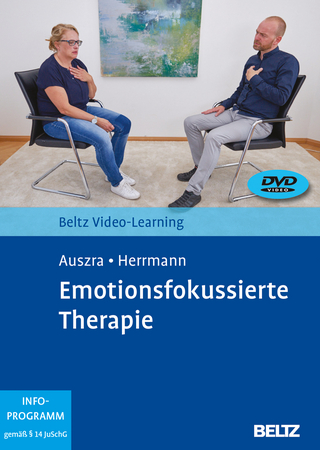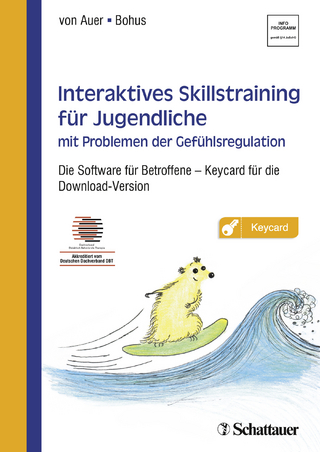
Obsessive Compulsive Disorder – Current Science and Clinical Practice
Wiley-Blackwell (Hersteller)
978-1-119-94112-5 (ISBN)
- Keine Verlagsinformationen verfügbar
- Artikel merken
Joseph Zohar is Department Chair of the Division of Psychiatry at Chaim Sheba Medical Center, Tel Hashomer, Israel. He is also Professor of Psychiatry at the Sackler School of Medicine, Tel Aviv University, Tel Aviv, Israel. He is President of the European College of Neuropharmacology, Associate editor of the World Journal of Biological Psychiatry and International editor of CNS. Dr. Zohar has received numerous awards, including: Fogarty International Research Fellowship Award, in 1984; A.E. Bennet Award for Clinical Research in 1986; European College of Neuropsychopharmacology Lilly Neuroscience Award for Clinical Research in 1998; and World Federation Society of Biological Psychiatry on excellency in education in 2001.
List of Contributors xii Introduction xvii SECTION 1 ASSESSMENT AND TREATMENT 1 Assessment 3 Jose M. Menchon Introduction 3 Detecting OCD 5 Screening in clinical interview 7 Structured interviews 8 Clinical assessment of obsessive-compulsive symptoms 9 Yale brown obsessive-compulsive scale 10 Dimensional yale brown obsessive-compulsive scale (DY BOCS) 11 Leyton obsessional inventory (LOI) 12 Maudsley obsessional-compulsive inventory (MOCI) 13 Padua inventory (PI) 13 Obsessive compulsive inventory (OCI) 14 Insight 14 Rating insight 15 Assessment of the risk of suicide 17 Differential diagnosis, comorbidities and related disorders 18 Organic brain disorders 19 Schizophrenia 20 Depression 20 Hypochondriasis 20 Phobias 21 Tourette disorder and tic disorders 21 Obsessive-compulsive personality disorder (OCPD) 21 Body dysmorphic disorder (BDD) 21 Hoarding 22 Other disorders 22 Conclusions 22 References 23 2 Pharmacotherapy of obsessive-compulsive disorder 31 Eric H. Decloedt and Dan J. Stein Introduction 31 Placebo-controlled studies of clomipramine 32 Placebo-controlled studies of fluvoxamine 32 Placebo-controlled studies of fluoxetine 33 Placebo-controlled studies of paroxetine 34 Placebo-controlled studies of sertraline 34 Placebo-controlled studies of citalopram/escitalopram 34 Placebo-controlled studies of venlafaxine 35 Improving early response in OCD 35 Special populations: children 36 Clomipramine 36 Fluvoxamine 36 Fluoxetine 36 Paroxetine 37 Sertraline 37 Citalopram 38 Meta-analyses 38 Tolerability of clomipramine and serotonin reuptake inhibitors 40 Optimal dose of treatment 41 Duration of treatment 42 Refractory OCD 43 Increased dose of SSRI 43 Augmentation of SSRI treatment with antipsychotics 44 Other drugs 45 Alternative modes of administration of SSRIs 46 Combining SRIs 46 Switching SSRIs 46 Adding psychotherapy 47 Future therapeutic options 47 Conclusion 48 References 48 3 Cognitive behavioural therapy in obsessive-compulsive disorder: state of the art 58 Martin E. Franklin, Addie Goss and John S. March Theoretical models 58 Treatment 60 Exposure plus response prevention (ERP) 60 Cognitive therapies 63 ERP plus medication 63 OCD protocols 64 Assessment 64 Adult ERP protocol 65 Paediatric ERP protocol 67 Dissemination 67 Future research 69 Summary 69 References 70 4 Electroconvulsive therapy, transcranial magnetic stimulation and deep brain stimulation in OCD 75 Rianne M. Blom, Martijn Figee, Nienke Vulink and Damiaan Denys Introduction 75 Electroconvulsive therapy 75 Transcranial magnetic stimulation 76 Mechanism of action 77 Efficacy of rTMS in OCD 77 Side effects and safety 84 Conclusion and future directions 85 Lesioning 85 Deep brain stimulation 86 Efficacy of DBS in OCD 86 Mechanism of action of DBS in OCD 92 Side effects of DBS in OCD 92 Follow-up treatment 94 Conclusions: DBS 94 Conclusion 94 Acknowledgements 95 References 95 5 Approaches to treatment resistance 99 Stefano Pallanti, Giacomo Grassi and Andrea Cantisani Terminological problems and operational definitions 100 Pharmacological strategies in resistant OCD 103 Switching 103 Infusion therapy 104 Cognitive behavioural therapy 105 Serotoninergic agents 106 Dopaminergic agents 108 Glutamatergic agents 113 Opioids 115 Physical therapies 115 Electroconvulsive therapy (ECT) 115 Repetitive transcranial magnetic stimulation (rTMS) 116 Deep brain stimulation (DBS) 116 Family intervention 117 Conclusions and future perspectives 117 References 118 SECTION 2 CLINICAL SPOTLIGHTS 6 Subtypes and spectrum issues 135 Eric Hollander, Steven Poskar and Adriel Gerard The obsessive-compulsive spectrum 135 Introduction 135 Cluster approach 135 Compulsivity and impulsivity 137 Repetitive behaviour domain 138 Determining placement of proposed OCSDs using cross-cutting domains 139 Obsessive-compulsive spectrum nosology 144 OCD subtypes: understanding the heterogeneity of OCD 148 Dimensional approach 148 Associated symptom domains 150 Compulsive hoarding: OCPD, OCD subtype, dimension, OCSD or something else? 151 Conclusion 154 References 154 7 Paediatric OCD: developmental aspects and treatment considerations 160 Daniel A. Geller, Alyssa L. Faro, Ashley R. Brown and Hannah C. Levy Introduction 160 Epidemiology 160 Aetiological considerations 161 Genetic factors 161 Non-genetic factors 164 Aetiology: summary 167 Clinical features 167 Gender and age at onset 168 Elaboration of phenotypic dimensions 168 Comorbid conditions 169 Neuropsychological endophenotypes 170 Clinical features: summary 170 Clinical assessment 171 Differential diagnosis 172 Normal development 172 Other psychiatric disorders 172 Treatment 173 Pharmacotherapy 174 Moderating effect of comorbid conditions 175 Multimodal treatment 176 Medication augmentation strategies in treatment resistance 177 Safety and tolerability 178 Treatment: summary 178 Course and prognosis 179 Conclusions and future research 179 Acknowledgements 180 References 180 SECTION 3 RESEARCH SPOTLIGHTS 8 Methodological issues for clinical treatment trials in obsessive-compulsive disorder 193 Samar Reghunandanan and Naomi A. Fineberg Introduction 193 Randomized controlled trials 194 The rationale of placebo 196 Recruitment criteria 199 Diagnosis 199 OCD dimensions and subtypes 200 The problem of comorbidity 201 Rating scales for OCD trials 203 Evaluating anxiety and depression in OCD 204 Measuring response and remission 205 Relapse prevention 207 Treatment-resistant OCD 208 Psychological treatment trials 209 Integrated pharmacological and psychological treatments in OCD 210 Health-related quality of life 211 Summary 211 References 212 9 Serotonin and beyond: a neurotransmitter perspective of OCD 220 Anat Abudy, Alzbeta Juven-Wetzler, Rachel Sonnino and Joseph Zohar Serotonin 221 Serotonin and metabolite concentrations in OCD 30 years later 222 Pharmacological challenge tests 224 Pharmacotherapy 225 Animal models and the role of serotonin 226 Dopamine 227 Dopamine and metabolite concentrations in humans 227 Pharmacological challenge tests 228 Pharmacotherapy 229 Animal models and the role of dopamine 231 Glutamate 232 The glutamatergic influence 232 Glutamate and metabolite concentrations in humans 232 Animal models and the role of glutamate 233 Serotonin: is it the one to blame? 233 The puzzle of antipsychotics and OCD: Is dopamine the answer? 234 So, is it a question of location? (Or ... location, location, location?) 234 References 235 10 Brain imaging 244 David R. Rosenberg, Phillip C. Easter and Georgia Michalopoulou Neuroimaging modalities 244 Structural assessment 244 Functional neurochemical assessment 245 Structural assessment of OCD 246 Total brain volume/ventricles 246 Basal ganglia 246 Prefrontal cortex 248 Medial temporal-limbic cortex 252 Pituitary 253 Supramarginal gyrus 253 White matter 254 Functional neuroimaging studies of OCD 255 Neurochemistry 258 Serotonin 258 N-acetyl-aspartate 258 Choline 259 Creatine/phosphocreatine 262 Glutamate 262 Conclusion 266 Acknowledgements 267 References 268 11 The genetics of obsessive-compulsive disorder: current status 277 David L. Pauls Introduction 277 Twin studies 277 Family studies 279 Family history studies 280 Family interview studies 280 Segregation analyses 284 Candidate gene studies 285 Genetic linkage studies 290 Future work 291 Acknowledgements 292 References 292 12 Neurocognitive angle: the search for endophenotypes 300 Samuel R. Chamberlain and Lara Menzies Introduction 300 Heritability of OCD 301 The concept of an endophenotype 302 Applying the endophenotype construct to OCD 305 Domains of interest in hierarchical modelling of OCD 307 Cognition 307 Neuroimaging 308 Searching for endophenotypes of OCD 311 Cognition 311 Neuroimaging 313 Other potential endophenotypes 316 Summary 317 Acknowledgements and disclosures 319 References 320 13 Conclusion and future directions 327 Joseph Zohar References 329 Index 331
| Verlagsort | Hoboken |
|---|---|
| Sprache | englisch |
| Maße | 168 x 244 mm |
| Gewicht | 666 g |
| Themenwelt | Geisteswissenschaften ► Psychologie ► Klinische Psychologie |
| Medizin / Pharmazie ► Medizinische Fachgebiete | |
| ISBN-10 | 1-119-94112-1 / 1119941121 |
| ISBN-13 | 978-1-119-94112-5 / 9781119941125 |
| Zustand | Neuware |
| Haben Sie eine Frage zum Produkt? |
aus dem Bereich

